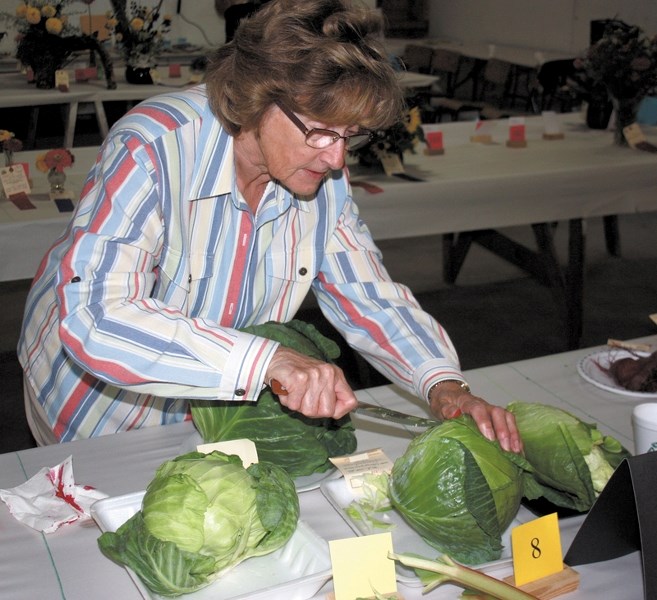There's more to growing a good crop of carrots, beets or beans than one might think.
There's more to growing a good crop of carrots, beets or beans than one might think.
For the dozens of people who entered fresh vegetables, fruits, grains and flowers in the horticulture competition at this year's Westlock & District Agricultural Fair, the slightest thing can mean the difference between first-place and disqualification.
Janice Felstad and Dian Dick, the two volunteers who run the horticulture portion of the contest, are both qualified to judge horticultural shows but don't judge locally because it would be too hard to be unbiased.
Instead, Edmonton's Lucy Holt explained the judging process while she did her work at the Ag Barn in Westlock last Thursday afternoon.
Peering over her glasses at several sets of beets, she explained that first and foremost, all entries must have the correct number of vegetables and be relatively uniform in length and size.
"That's standard to most categories," she said.
With beats, it's also important to have a half-inch of greens left on top, and for the insides of the beets to be relatively uniform. One does not want to see any white rings.
Beans, meanwhile, have some other aspects that become more important than just visuals - they have to have a nice snap to them, or else they'll never take the top spot.
It's also important that they are harvested before they get too big.
"We don't want to see any big seed pods inside," Holt said.
Moving on to the cabbage, she sliced wedges out of all the entries to see how densely packed the leaves are - and also to ensure there are no bugs, something that any gardener will tell you can be a problem with cabbage.
Carrots seemed to be one of the more popular entries this year, with several sets for Holt to examine, and in several different categories based on length.
For all the categories of carrot, though, there are some common themes.
First off, you don't want any horizontal ridges along the carrots that could trap a bit of dirt in them. A smooth surface is best.
It's also important that the carrots don't have any green on the root part of the vegetable - a problem Holt said can be rectified by hilling the plants while they're still in the ground.
Cutting the carrots open is also an important indicator.
"The core inside is supposed to be small and darker than the rest of the carrot," she said. Many of the entries were lacking in that department.
For those who enter the competition, it's not necessarily important whether you win or lose. It's just about the fun of participating.
Elisabeth Rottier said she didn't think she would take first place in anything this year, but that didn't really bother her.
"It doesn't matter," she said. "It's about the participation."
Mary Kenyon, who lives on a farm in the Barrhead area, said she takes part in these competitions simply because she enjoys it so much. So much, in fact, that she didn't get much sleep Wednesday night because she was preparing her 74 entries for the competition.
"It's all for the fun of it, I guess," she said. "And the challenge."
Westlock County's Even Woynoroski did a good job representing the area's farming community, displaying a variety of grains and forage crops. Most striking was a corn plants that looked to be nearly twice as tall as the six-foot farm boy.
"This corn was grown in a field as forage crop," he said. "It can get a lot taller, too."
The secret to his success, he said, had a little bit to do with using enough fertilizer and a lot to do with getting the right amount of rain at the right times.
"The moisture is pretty important," he said.
For all of the passion displayed by the many presenters, there were many categories that only received one or two entries. That doesn't mean, however, that just anyone can get first place by default.
Holt doesn't hesitate to give out second- and third-place prizes even if there's just one entry in the class.
"The quality has to be there," she said.
The standards of quality are laid out in a book, "Judging and Exhibiting Standards for Horticultural Shows." At one point judges were required to do courses to judge the shows, but since the college in Olds no longer offers the courses in question, judges are now trained through an apprenticeship program with the Alberta Horticulture Association.
For more information about horticultural compeitions, visit www.icangarden.com/clubs/AHA or contact the Westlock Ag Society.
